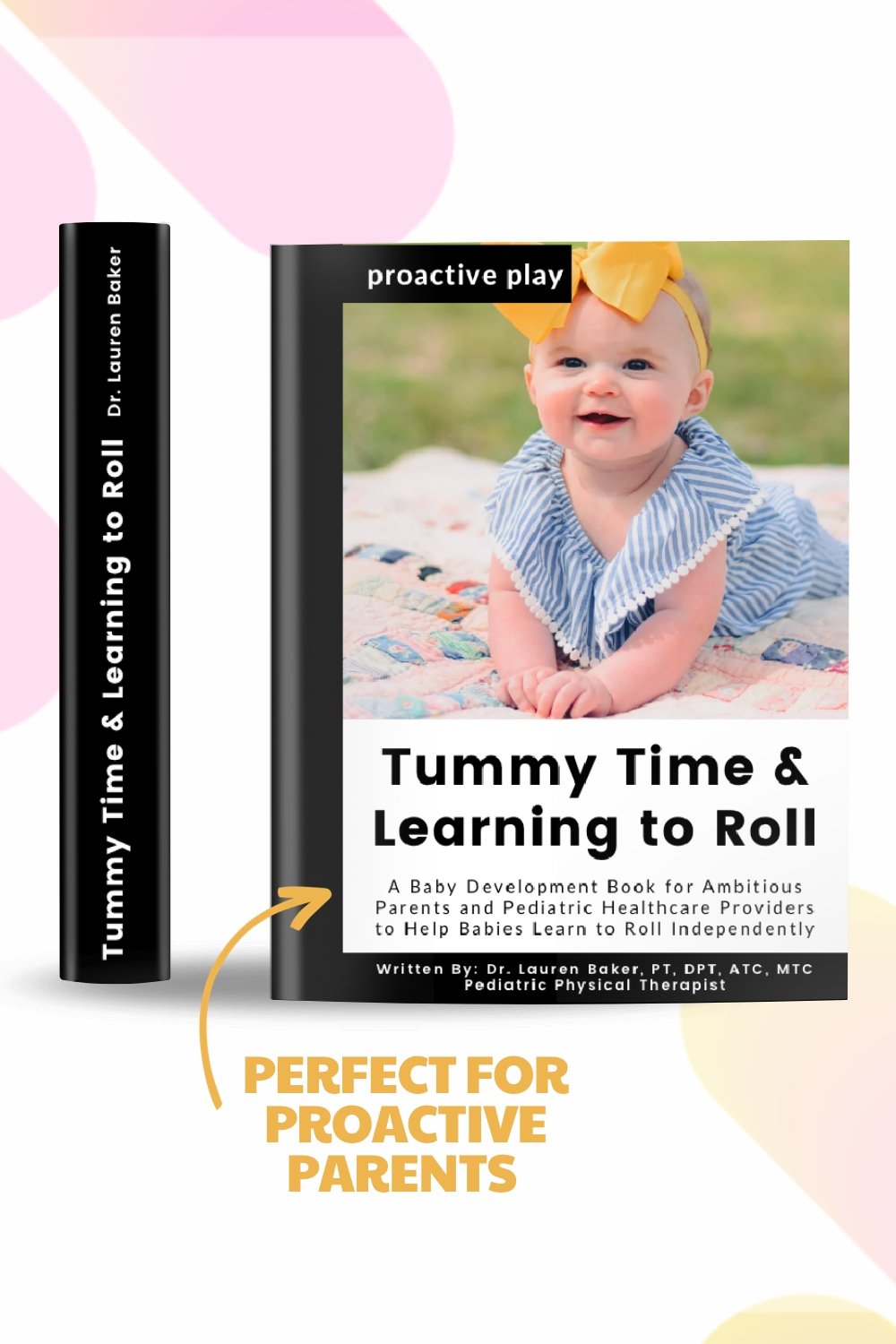Guiding Your Baby's First Movements: Pediatric Physical Therapy Activity for Newborns to 3-Month-Olds
In this blog post, we're delving into an essential topic for new parents: physical therapy exercises for newborns and 3 month-old babies.
👋Hi I am Dr. Lauren Baker, a Pediatric Physical Therapist and I created this YouTube video to provide insights for parents seeking to support their baby's early physical development, especially getting babies in proactive play positions that can help them build the muscles they need for their next season of milestones, in this case, rolling (4-6 months).
The activity we are going over today, works on flexing the spine and tilting the pelvis, which are needed so that the baby can be ready for rolling, sitting, and crawling. This activity and exercise is especially important for babies who tend to arch their backs or who have experienced reflux or unique in utero positions.
These conditions can lead babies to prefer an extended posture, which we need to gently correct to aid their overall development. By gently guiding babies through these exercises, parents can help break the habit of extension, which can be disadvantageous for babies.
The bonus is this exercise takes almost no actual brain power from parents and is super easy to slip into their normal day without much thought.
The exercise in today’s video involves propping the baby's bottom up on a parent's foot, leg, or a folded bath towel while supervised. This simple yet effective position helps babies relax into a posterior pelvic tilt, a fundamental posture for further developmental progress.
The posterior pelvic tilt or rounding of the baby’s back will also support development for later mini milestones such as grabbing their feet while on their and back rolling to their sides. It's an activity that parents can easily integrate into their daily routine, requiring minimal effort but offering significant benefits.
If babies struggle with tilting their pelvis or look uncomfortable when placed in this position, it is important to decrease the length of time to their tolerance, even if their tolerance is only at 5-10 seconds before they kick out of the position. Completing this position/exercise frequently but in low amounts of time, can increase tolerance through gentle familiarization.
If a baby continues to avoid this position, they are at risk for potential difficulty with rolling, sitting, or crawling as all of those positions also require a rounding of the spine and tilting of the pelvis. If a baby cannot tolerate this position when they are a newborn, they may struggle once more challenges of gravity and positioning occur.
In order of ease & activities that require this same positioning of the body:
Posterior Pelvic Tilt/Rounding of spine (this exercise)
Lying on their side
Rolling back to side
Rolling back to belly
Sitting
Crawling
This exercise is great for newborns to 3 month olds, but I have also utilized it in my Pediatric Physical Therapy practice with babies who are 4-7 months if they are struggling with rolling or sitting. This premise is also utilized in other activities for littles who are struggling with crawling or walking, but this exercise isn’t the best because usually by 8 months they are too wiggly to stay on their back :).
The video demonstrates how this position not only promotes physical development but also provides opportunities for interactive play. Parents can incorporate grabbing and abdominal activation by helping the baby play with their feet, making the exercise both beneficial and enjoyable for the baby.
It is recommended to maintain this position for one to five minutes, allowing the baby to comfortably acclimate to it. Longer durations (more time) allow the baby to develop abdominal muscle strength (ability to get the body part to the position without letting gravity force it to the ground) AND endurance (ability to hold a body part in a position for a long period of time) as well as hand/eye, hand/foot coordination.
The approach I utilize is all about empowering parents with the knowledge and skills to facilitate their baby's development through strategic play and movement activities. I believe through proactive play that we can help babies avoid preventable motor delays and help parents connect more deeply with their babies.
For the full example on how to complete the exercise including a demonstration on a newborn, see the video below:
Curious about learning more on Tummy Time, Rolling, or Both?
The absolute best book for parents on tummy time and rolling is: Tummy Time and Learning to Roll: A Baby Development Book for Ambitious Parents and Pediatric Healthcare Providers to Help Babies Learn to Roll Independently. The book comes with a free online video course to help parents fully understand how to complete the different exercises, printable checklists to know exactly where your baby is at, and when to reach out for additional help.
This book was written by Dr. Lauren Baker, PT, DPT, ATC, MTC, who is a Pediatric Physical Therapist in Boise, Idaho, trained in helping parents learn how to help their babies move and master their milestones. She loves teaching parents how to see how their babies are moving as well as how to influence those movements though play positions and exercises to help babies move with confidence and ease.
Tummy Time and Learning to Roll is the first book in the Proactive Play series written by Pediatric Physical Therapist Dr. Lauren Baker in order to help Ambitious Parents and Pediatric Healthcare Providers learn how to help babies master tummy time and learn to roll. It is meant to help ambitious parents understand baby development from birth to six months (tummy time to rolling).
This book is a mix of easy-to-follow and more in-depth information than is typically found in baby development books because Dr. Baker believes parents deserve to have all the information at their fingertips.
This book breaks down each piece of movement in checklists so that parents know what their babies need for tummy time and rolling. It also covers what areas might limit a child with rolling, why it is so important, and when to seek help from a pediatric PT.
This book comes with colored photos and easy-to-follow demonstration videos that can help parents implement safe, strategic play-based exercises with their babies in 20 minutes per day.
A Great Resource For:
Parents and Pediatric Healthcare Providers of babies 0-6 months
Parents of babies who are struggling with tummy time, rolling back to belly, belly to back, or only to one side
Access to simple, easy-to-follow videos of play positions and exercises
Learning the four pillars of movement needed in order to master rolling
240+ Color Photo Examples of:
Tummy Time, Sidelying, and Back Play
Developmental Toys and Equipment
Hand Placement and Strategic Play Positions
Common Areas of Restriction or Weakness
When To Reach Out For Help
What If You Want Extra Help?
If you have concerns about their movement, remember, you can always reach out to a pediatric physical therapist. It's your right as a parent to advocate for your child's development. Sometimes, a few tips and tricks are all you need to get your baby moving better. We're here to support you and release those mama worries. If you are looking for in home pediatric physical therapy, check our listing of therapists.
For those eager to learn more or seeking personalized guidance, I offer online video parent consultations internationally and Pediatric Physical Therapy in Boise, ID and the Treasure Valley – by clicking to the appointment tab or by clicking here. I am dedicated to answering questions and providing tailored play activities for each unique developmental journey.
Remember, these early months are crucial for your baby's development. By incorporating these simple physical therapy exercises for your newborn or 3-month-old, you're setting a strong foundation for their future milestones, including rolling and tolerating tummy time.
Stay tuned for more insights from Dr. Lauren Baker, your go-to expert for nurturing your baby's early steps in life. If you have not yet, subscribe to our youtube channel.



